Advanced Magnetic Coupling Resonance Model Optimization for Enhanced Wireless Power Transfer
Abstract
:1. Introduction
2. Circuit Modeling Analysis of MCR-WPT Coupled System
2.1. Modeling Analysis of Magnetically Coupled Resonators
2.2. Optimized Design of MCR-WPT Transmission Performance and Coil Parameters
2.3. Optimization of Coil Parameter Selection
3. Analysis of Key Technologies for MCR-WPT System Design
3.1. System Components
3.2. All-Digital Phase-Locked Loop Structure and Modeling Analysis
4. MCR-WPT System Simulation and Verification
4.1. Simulation of Radio Energy Transmission System
4.2. Experimental Platform Construction and Waveform Testing
4.3. Transmission Performance Tests with Different Structural Parameters
5. Summary and Outlook
Author Contributions
Funding
Data Availability Statement
Conflicts of Interest
References
- Li, X.; Zhang, H.; Peng, F.; Li, Y.; Yang, T.; Wang, B.; Fang, D. A Wireless Magnetic Resonance Energy Transfer System for Micro Implantable Medical Sensors. Sensors 2012, 12, 10292–10308. [Google Scholar] [CrossRef] [PubMed]
- Zhou, W.; Sandeep, S.; Wu, P.; Yang, P.; Yu, W.; Huang, S.Y. A Wideband Strongly Coupled Magnetic Resonance Wireless Power Transfer System and Its Circuit Analysis. IEEE Microw. Wirel. Compon. Lett. 2018, 28, 1152–1154. [Google Scholar] [CrossRef]
- Pries, J.; Galigekere, V.P.N.; Onar, O.C.; Su, G.J. A 50-kW Three-Phase Wireless Power Transfer System Using Bipolar Windings and Series Resonant Networks for Rotating Magnetic Fields. IEEE Trans. Power Electron. 2020, 35, 4500–4517. [Google Scholar] [CrossRef]
- Lim, Y.; Tang, H.; Lim, S.; Park, J. An Adaptive Impedance-Matching Network Based on a Novel Capacitor Matrix for Wireless Power Transfer. IEEE Trans. Power Electron. 2014, 29, 4403–4413. [Google Scholar] [CrossRef]
- Yuan, S.; Cui, Y.; Wang, J.; Fan, H.; Fan, Y. Research on impedance matching method for magnetically coupled resonant wireless energy transmission system. Ind. Min. Autom. 2019, 45, 6. [Google Scholar]
- Cheng, Z.; Lu, Y.; Liu, Q.; Xing, Y. Research on adaptive tuning of coupled resonant wireless energy transmission based on magnetic amplifier. J. Electrotechnol. 2018, 33, 8. [Google Scholar]
- Li, Y.; Dong, W.; Yang, Q.; Zhang, Q.; Liu, L. Power reduction mechanism and improvement method of over-coupled wireless energy transmission. J. Electrotechnol. 2018, 33, 8. [Google Scholar]
- Li, H.; Li, J.; Wang, K.; Chen, W.; Yang, X. A Maximum Efficiency Point Tracking Control Scheme for Wireless Power Transfer Systems Using Magnetic Resonant Coupling. IEEE Trans. Power Electron. 2015, 30, 3998–4008. [Google Scholar] [CrossRef]
- Cheng, L.; Cui, Y.; Yan, G. Research on frequency tracking control of magnetically coupled resonant wireless energy transmission. Power Electron. Technol. 2014, 48, 4. [Google Scholar]
- Zhou, H.; Yao, G.; Ma, L.; Wei, W. Research on resonant frequency tracking method of ICPT system. Power Electron. Technol. 2013, 47, 3. [Google Scholar]
- Liu, W.-T.; Li, Y.-X.; Cui, Y.; Huang, K.; Bian, X. FPGA-based frequency tracking control of magnetically coupled resonant wireless energy transmission. J. Electrotechnol. 2018, 33, 9. [Google Scholar] [CrossRef]
- Wang, W.J. Analysis and Design of Magnetically Coupled Resonant Wireless Power Supply System. Ph.D. Thesis, Anhui University of Technology, Maanshan, China, 2015. [Google Scholar]
- Liu, J. Design and Research of Wireless Energy Transmission System Based on Low-Frequency Compact Metamaterials. Ph.D. Thesis, Zhejiang University, Hangzhou, China, 2022. [Google Scholar]
- Li, D.; Qin, Q. The invention relates to an intermediate frequency power supply fast startand digital phase locked loop control technology. J. Phys. Conf. Ser. 2021, 2137, 012016. [Google Scholar] [CrossRef]
- Yang, Y.; Xu, Y.; Yao, W.; Chen, S. Efficiency analysis of three-coil resonant structure for wireless energy transmission system. Power Electron. Technol. 2020, 54, 27–29+38. [Google Scholar]
- Chen, X.; Zhou, A.; Mao, J.; Wang, P. Research on a multi-carrier access MCR WPT system with relay coil. Power Electron. Technol. 2021, 55, 114–117. [Google Scholar]
- Chen, F. Design of Wireless Power Supply System for Magnetically Coupled Resonant UAV. Ph.D. Thesis, Hebei University of Technology, Tianjin, China, 2017. [Google Scholar]
- Nguyen, M.Q.; Hughes, Z.; Woods, P.; Seo, Y.S.; Rao, S.; Chiao, J.C. Field Distribution Models of Spiral Coil for Misalignment Analysis in Wireless Power Transfer Systems. IEEE Trans. Microw. Theory Tech. 2014, 62, 920–930. [Google Scholar] [CrossRef]
- Chen, Q.; Fan, F.; Wang, J.; Chen, W.; Deng, X. Accurate evaluation method of Litz coil AC resistance for magnetic coupling system of wireless energy transmission. J. Electrotechnol. 2022, 37, 6294–6305. [Google Scholar]
- Li, C.; Zhang, H.; Cao, J.; Liu, M. Analysis and optimization of power and efficiency transmission characteristics of magnetic resonance coupled electric energy transmission system. Power Syst. Autom. 2015, 6, 92–97. [Google Scholar] [CrossRef]
- Li, Y.; Ma, J.; Li, M.; Liu, L.; Zhao, J.; Liu, X. Design and optimization of magnetic coupling coils for wireless energy transmission. Electr. Appl. Energy Effic. Manag. Technol. 2019, 56–62+70. [Google Scholar]
- Zou, Q.; Wang, J.; Yu, W.; Xu, X.; Liu, Y. Research on low-voltage high-current topology based on synchronous rectification technology. Electrotechnology 2022, 3, 74–76. [Google Scholar]
- Hao, H.; Zhang, X.; Guo, Y. Research and design of series-parallel wireless energy transmission system. Electron. Des. Eng. 2019, 27, 133–137. [Google Scholar]

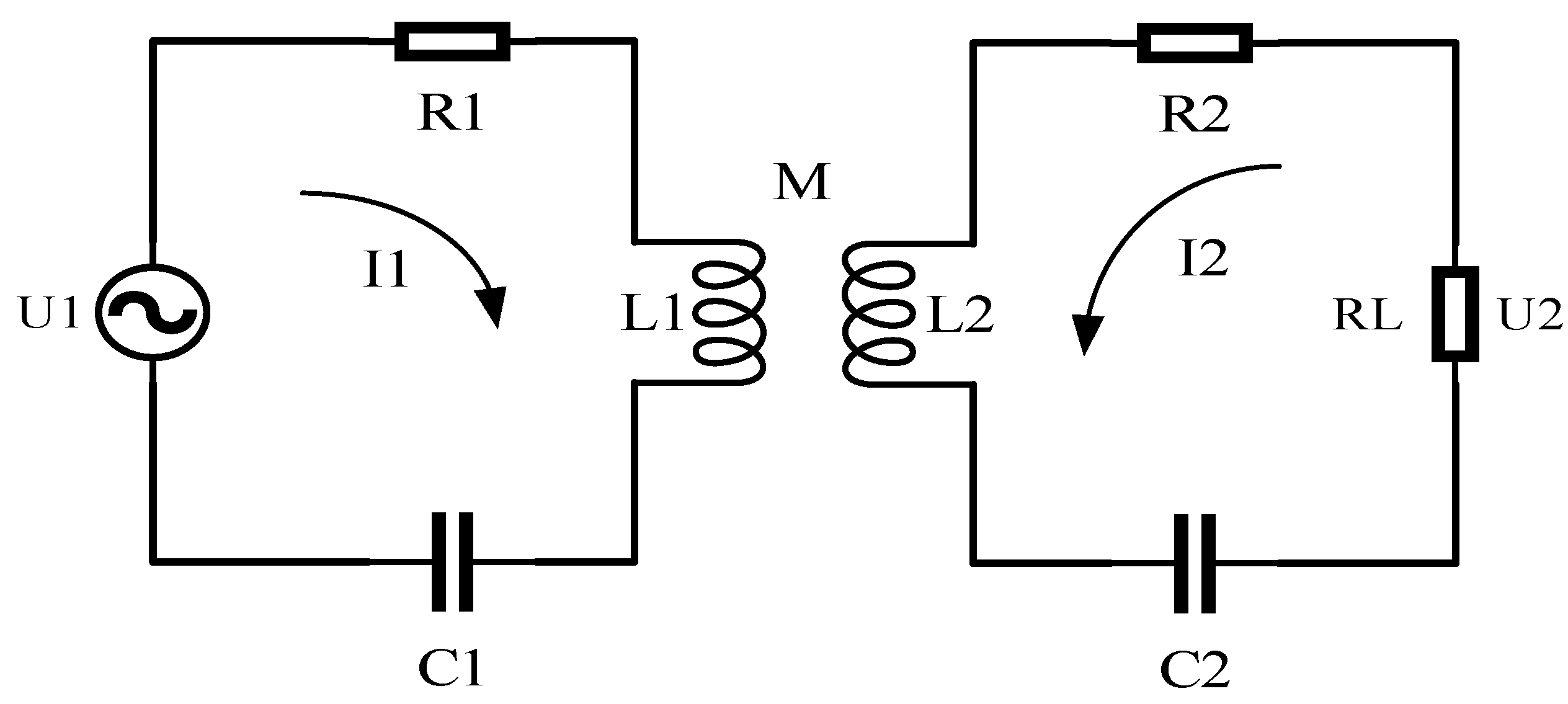
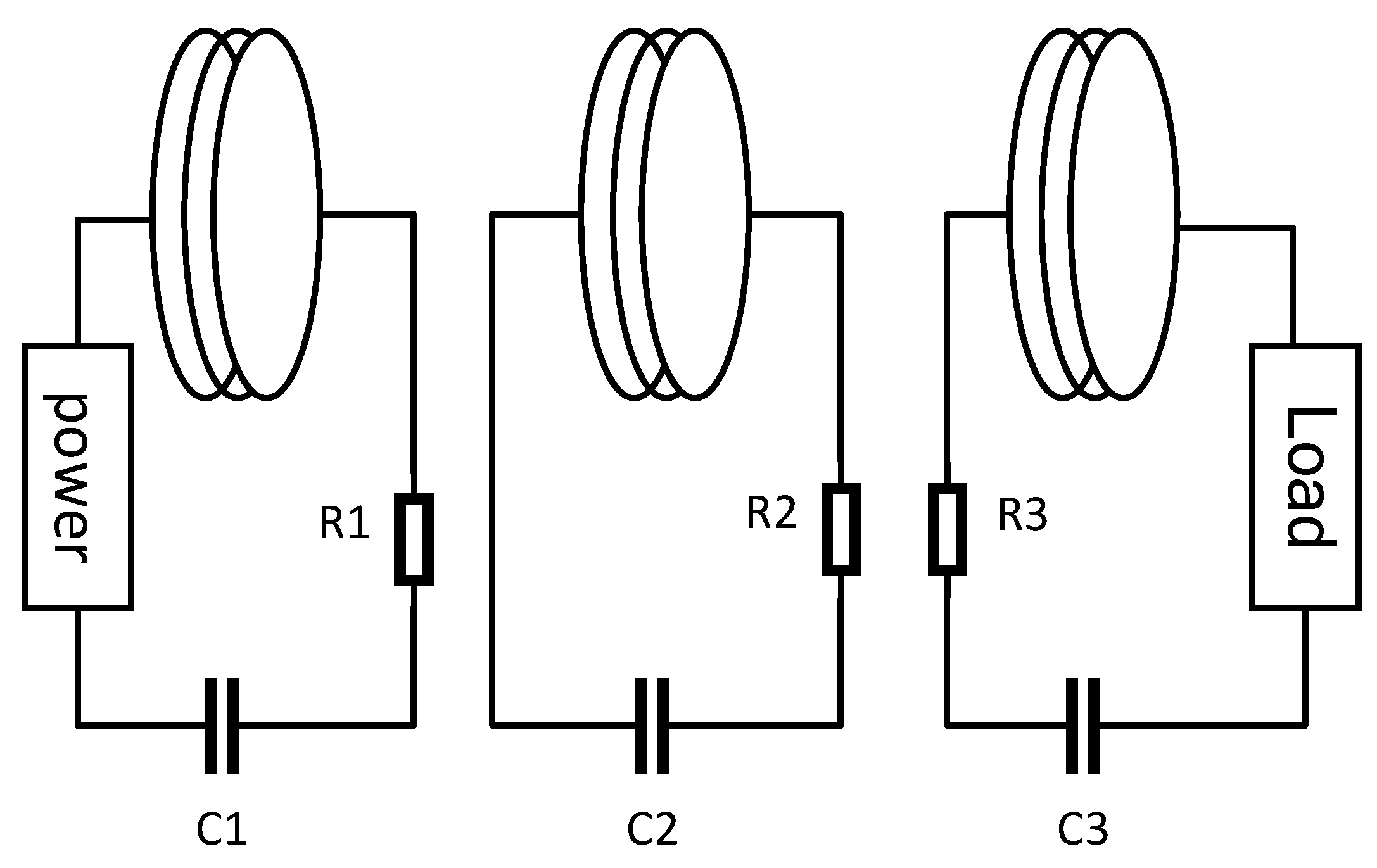





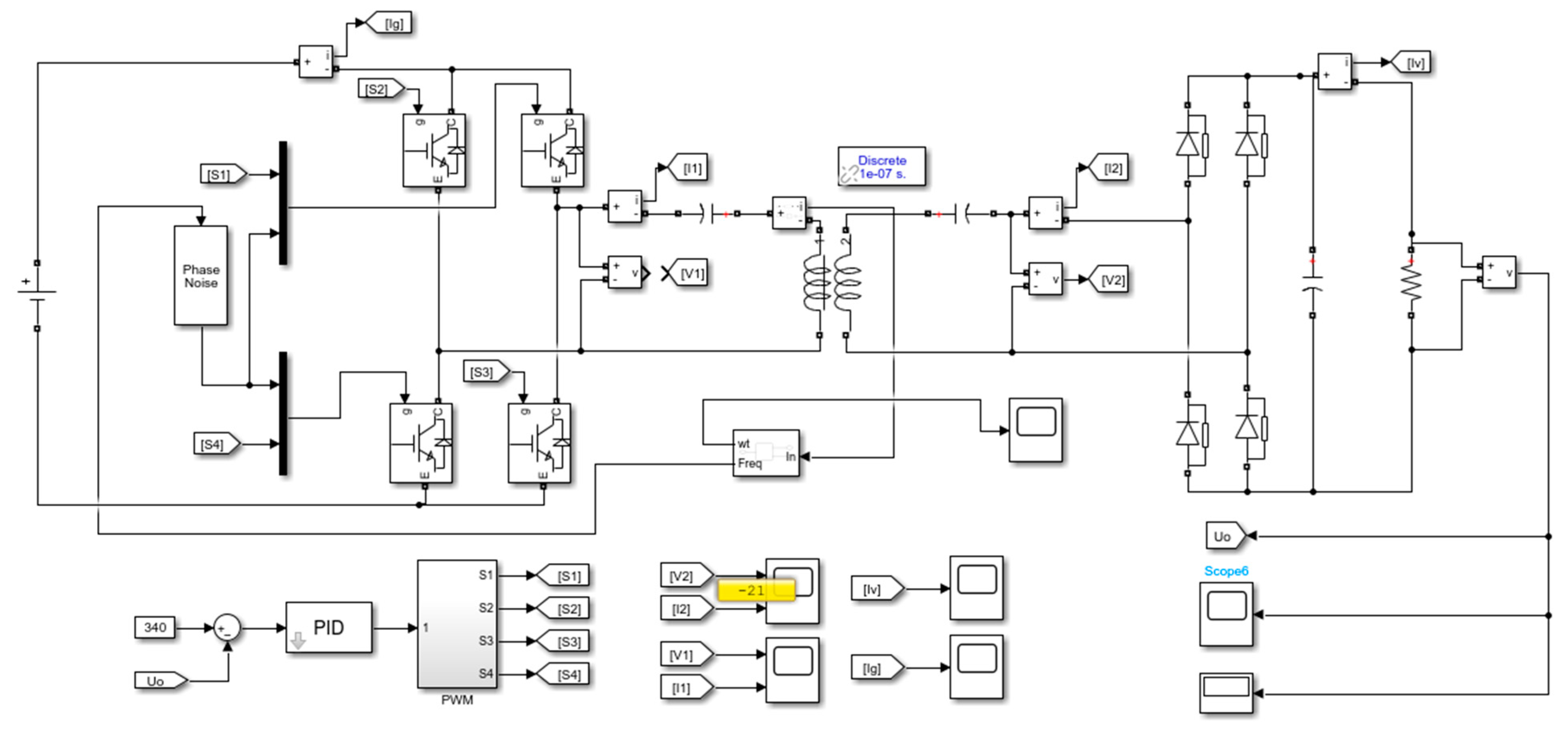






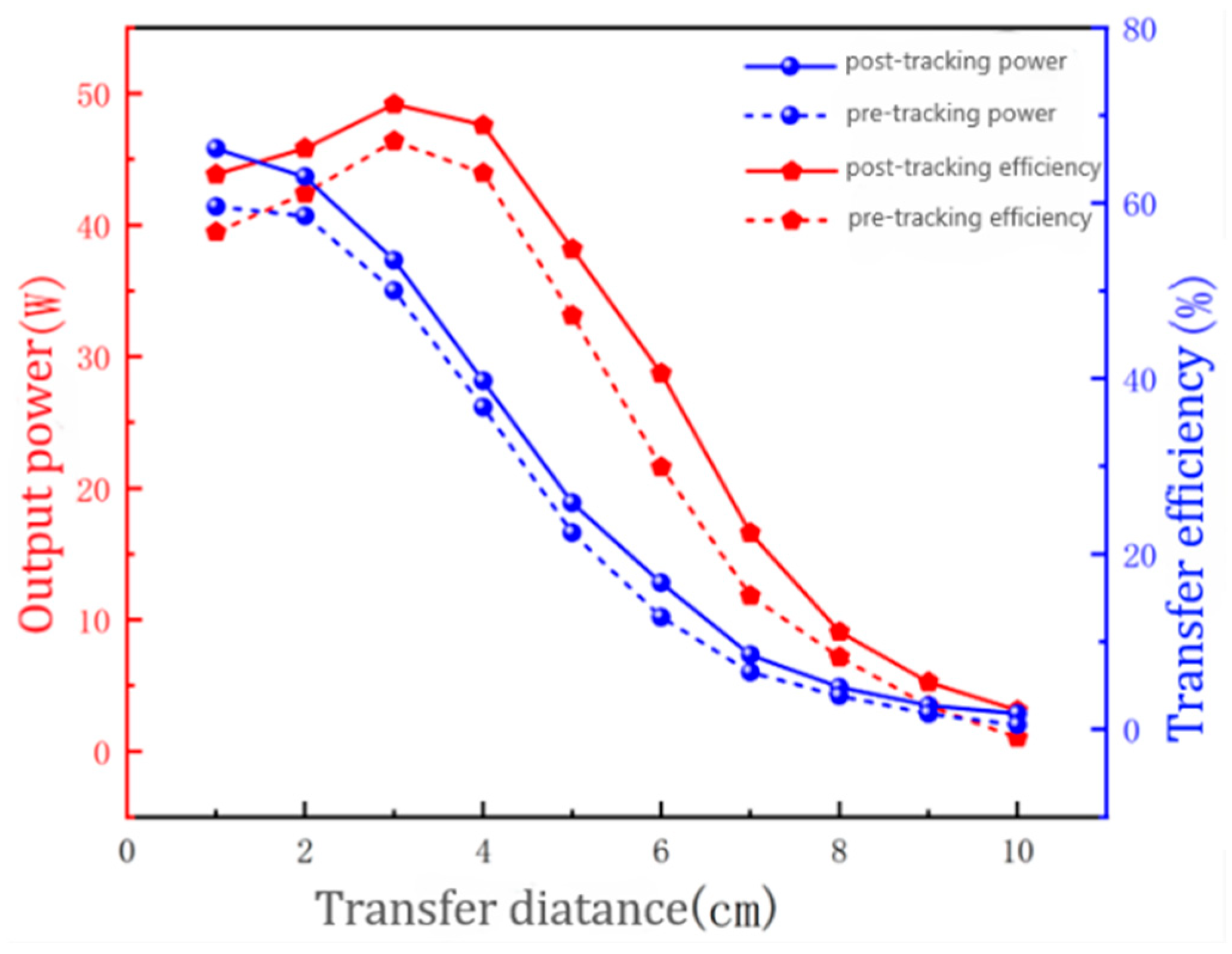
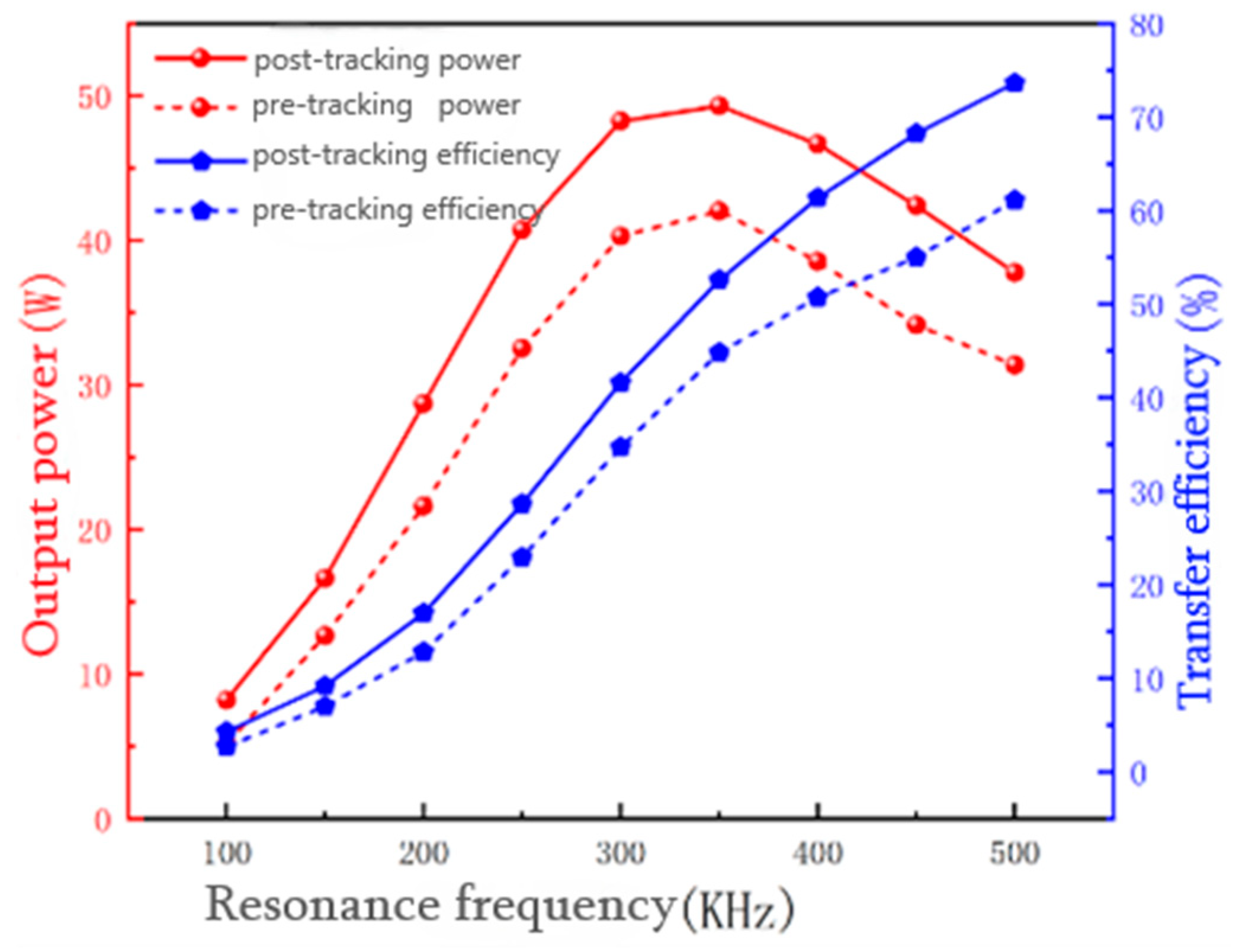
| WPT Classification | Electromagnetic Induction (MIC-WPT) | Magnetically Coupled Resonant (MCR-WPT) | Microwave Radiometric (MWPT) |
|---|---|---|---|
| transmission principle | magnetic coupling | magnetic coupling | electromagnetic radiation |
| transmission distance | centimeter scale | meter scale | kilometer scale |
| transmission power | kilowatt class (unit of electric power) | kilowatt class (unit of electric power) | megawatt-class |
| transmission efficiency | >85% | ≈80% | ≈40% |
| operating frequency | 10 kHz–50 kHz | 20 kHz–500 MHz | 300 MHz–300 GHz |
| Turns | Average Radius | ||||||
|---|---|---|---|---|---|---|---|
| 14 cm | 15 cm | 16 cm | 17 cm | 18 cm | 19 cm | 20 cm | |
| 14 | 248.857 | 190.947 | 150.486 | 121.325 | 99.732 | 83.359 | 70.684 |
| 15 | 190.129 | 145.706 | 114.728 | 92.434 | 75.943 | 63.450 | 53.784 |
| 16 | 147.638 | 113.036 | 88.943 | 71.622 | 58.820 | 49.128 | 41.634 |
| 17 | 116.319 | 88.992 | 69.985 | 56.333 | 46.250 | 38.620 | 32.722 |
| 18 | 92.844 | 70.990 | 55.805 | 44.905 | 36.858 | 30.771 | 26.068 |
| 19 | 74.981 | 57.305 | 45.032 | 36.226 | 29.729 | 24.815 | 21.020 |
| 20 | 61.201 | 46.755 | 36.731 | 29.543 | 24.240 | 20.231 | 17.135 |
| Number of Turns | Average Radius | ||||||
|---|---|---|---|---|---|---|---|
| 14 cm | 15 cm | 16 cm | 17 cm | 18 cm | 19 cm | 20 cm | |
| 14 | 97.835 | 98.136 | 98.350 | 98.505 | 98.619 | 98.704 | 98.767 |
| 15 | 98.143 | 98.383 | 98.552 | 98.672 | 98.758 | 98.821 | 98.866 |
| 16 | 98.374 | 98.567 | 98.670 | 98.793 | 98.857 | 98.902 | 98.933 |
| 17 | 98.550 | 98.704 | 98.809 | 98.880 | 98.928 | 98.959 | 98.978 |
| 18 | 98.684 | 98.808 | 98.889 | 98.943 | 98.977 | 98.996 | 99.006 |
| 19 | 98.786 | 98.885 | 98.948 | 98.987 | 99.009 | 99.020 | 99.021 |
| 20 | 98.865 | 98.943 | 98.991 | 99.018 | 99.030 | 99.032 | 99.027 |
Disclaimer/Publisher’s Note: The statements, opinions and data contained in all publications are solely those of the individual author(s) and contributor(s) and not of MDPI and/or the editor(s). MDPI and/or the editor(s) disclaim responsibility for any injury to people or property resulting from any ideas, methods, instructions or products referred to in the content. |
© 2025 by the authors. Licensee MDPI, Basel, Switzerland. This article is an open access article distributed under the terms and conditions of the Creative Commons Attribution (CC BY) license (https://creativecommons.org/licenses/by/4.0/).
Share and Cite
Zhang, H.; Liu, S.; Liu, J. Advanced Magnetic Coupling Resonance Model Optimization for Enhanced Wireless Power Transfer. Electronics 2025, 14, 1152. https://doi.org/10.3390/electronics14061152
Zhang H, Liu S, Liu J. Advanced Magnetic Coupling Resonance Model Optimization for Enhanced Wireless Power Transfer. Electronics. 2025; 14(6):1152. https://doi.org/10.3390/electronics14061152
Chicago/Turabian StyleZhang, Huixin, Sichen Liu, and Jialong Liu. 2025. "Advanced Magnetic Coupling Resonance Model Optimization for Enhanced Wireless Power Transfer" Electronics 14, no. 6: 1152. https://doi.org/10.3390/electronics14061152
APA StyleZhang, H., Liu, S., & Liu, J. (2025). Advanced Magnetic Coupling Resonance Model Optimization for Enhanced Wireless Power Transfer. Electronics, 14(6), 1152. https://doi.org/10.3390/electronics14061152








